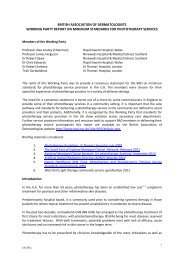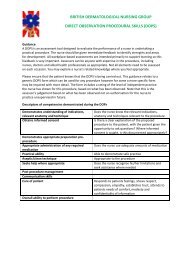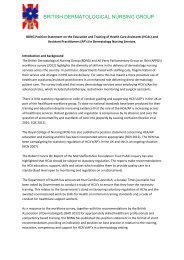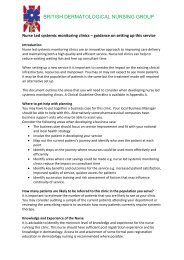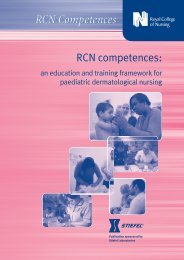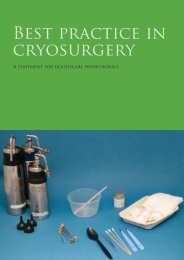Improving outcomes for people with skin tumours including melanoma
Improving outcomes for people with skin tumours including melanoma
Improving outcomes for people with skin tumours including melanoma
Create successful ePaper yourself
Turn your PDF publications into a flip-book with our unique Google optimized e-Paper software.
<strong>Improving</strong> Outcomes <strong>for</strong><br />
People <strong>with</strong> Skin Tumours<br />
<strong>including</strong> Melanoma<br />
Organisation of <strong>skin</strong><br />
cancer services<br />
• Be responsible <strong>for</strong> the provision of in<strong>for</strong>mation, advice and<br />
support <strong>for</strong> all patients and their carers throughout the course of<br />
the illness; this should include those who are receiving most of<br />
their care from doctors outside the MDT, e.g. physicians caring<br />
<strong>for</strong> the elderly.<br />
• Provide treatment and follow-up <strong>for</strong> patients and ensure that<br />
every patient <strong>with</strong> invasive <strong>skin</strong> cancer is documented<br />
(discussed or audited) by the MDT.<br />
• Audit the management of all patients <strong>with</strong> excised BCCs and<br />
SCCs not discussed at MDT meetings. This audit should be<br />
presented to the MDT on a quarterly basis.<br />
3<br />
• Provide a rapid referral service to the SSMDT <strong>for</strong> patients who<br />
require specialist management (see Table 4).<br />
• Ensure that GPs are given prompt 21,22 and full in<strong>for</strong>mation about<br />
any changes in their patients’ illness or treatment.<br />
• Refer cases requiring a second histological opinion to the lead<br />
histopathologist in the SSMDT.<br />
• Ensure that all eligible patients are entered into approved<br />
clinical trials. If the trial is coordinated through the SSMDT then<br />
all patients (regardless of stage) who are eligible should be<br />
referred to the SSMDT.<br />
• Collect data <strong>for</strong> network-wide audit (Table 3).<br />
Cases to be discussed at LSMDTs are summarised in Table 2. LSMDTs<br />
will concurrently refer certain patients on to the SSMDT (see Table 4).<br />
Any patients who are recognised (clinically or histologically) to have<br />
<strong>skin</strong> cancers <strong>with</strong> the characteristics listed in Table 4 should be<br />
referred directly to the SSMDT.<br />
In some cases, direct referral from the community to the SSMDT may<br />
be appropriate, <strong>for</strong> example in the rare situation where a GP finds<br />
that he or she has excised an MM. However, there may be benefits to<br />
a patient in being referred simultaneously to both LSMDT and SSMDT<br />
and meeting a member of the LSMDT early, because follow-up may<br />
take place there at a later date.<br />
21 Department of Health (2004) Manual <strong>for</strong> cancer services. Available from: www.dh.gov.uk<br />
22 Welsh Assembly Government (2005) National Standards <strong>for</strong> Skin Cancer Services.<br />
Available from: www.wales.gov.uk/subihealth/content/cancer/national-standards-e.htm<br />
52<br />
National Institute <strong>for</strong> Health and Clinical Excellence




